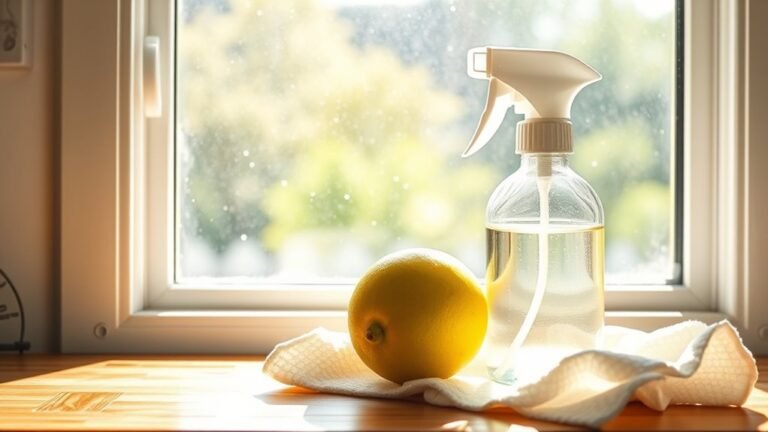Cleaning and Caring for Terracotta Tiles
To keep your terracotta tiles looking warm and beautiful, sweep regularly with a soft broom to avoid scratches, and mop gently using a pH-neutral cleaner. Address spills quickly to prevent stains, and avoid harsh scrubbing. Seal your tiles every 1-2 years to protect their porous surface from moisture and damage. Outdoor tiles need extra weatherproofing and proper drainage. Follow these simple steps, and you’ll discover even more ways to maintain their rustic charm and durability over time.
Understanding Terracotta Tile Characteristics
Terracotta tiles are known for their warm, earthy tones and porous texture, which give them a unique charm but also require special care. When you understand the terracotta properties, you’ll appreciate why these tiles need gentle handling. Their porous nature means they can absorb liquids and stains easily, so sealing is key to maintaining tile durability. You want your tiles to last without losing their natural beauty, right? Unlike glazed tiles, terracotta’s unglazed surface offers a rustic look but demands regular maintenance to prevent damage. Knowing these characteristics lets you embrace the freedom to enjoy your space without worrying about wear and tear. With the right care, your terracotta tiles will stay both stunning and strong over time.
Preparing Your Cleaning Supplies
Since these tiles soak up stains easily, you’ll want to gather the right cleaning supplies before you start. Choosing the right cleaning tools and eco friendly solutions helps you protect your tiles and the environment, giving you freedom from harsh chemicals. Here’s what you’ll need:
- Soft-bristle brush or mop to avoid scratching.
- pH-neutral, eco friendly cleaner designed for terracotta.
- Microfiber cloths for gentle wiping and drying.
- Bucket for mixing your cleaning solution.
Avoid acidic or abrasive products that damage the tile’s surface. With these supplies ready, you’re set to clean effectively without compromising your tiles’ natural beauty or your values. Preparing well lets you enjoy the freedom of a fresh, clean space with sustainable choices.
Regular Sweeping and Dusting Techniques

A regular sweep and dust can make a big difference in keeping your tiles looking fresh. To enjoy the freedom of a carefree home, adopt effective sweeping techniques that remove dirt without damaging your terracotta. Use a soft-bristle broom and sweep gently in one direction to lift dust instead of pushing it around. Pair this with reliable dust collection methods—like a vacuum with a hard floor setting or a microfiber dust mop—to capture particles efficiently. Avoid harsh scrubbing or metal bristles that can scratch your tiles. By staying consistent with these simple steps, you’ll maintain your terracotta’s natural beauty and preserve your space’s open, inviting vibe. Regular care means more freedom to enjoy your home without worrying about grime buildup.
Best Practices for Wet Cleaning
While dry cleaning keeps surface dust at bay, wet cleaning is essential to remove deeper dirt and stains from your terracotta tiles. To keep your floors looking fresh without restricting your freedom, follow these best practices for wet cleaning:
- Choose gentle cleaning solutions—avoid harsh chemicals that can damage the porous surface.
- Use a damp mop with proper mopping techniques, wringing out excess water to prevent soaking.
- Mop in sections, rinsing your mop frequently to avoid spreading dirt.
- Allow tiles to air dry naturally; avoid heavy foot traffic until fully dry.
Removing Stains From Terracotta Tiles
Though terracotta tiles are durable, stains can still happen and might seem tough to remove. Understanding different stain types—like oil, rust, or organic matter—helps you choose the right removal techniques. For oil-based stains, use a gentle degreaser or baking soda paste to lift the grime without damaging your tiles. Rust stains respond well to a diluted lemon juice application, followed by thorough rinsing. Organic stains, like coffee or wine, often need a mild detergent and warm water. Always test your chosen method on a small, hidden area first to avoid unwanted damage. By tailoring your approach to the stain type, you keep your terracotta tiles looking fresh and free, letting you enjoy their natural beauty without worry.
Sealing Terracotta Tiles for Protection
Now that your terracotta tiles are clean, you’ll want to protect them by choosing the right sealer. Applying it correctly guarantees long-lasting results and keeps your tiles looking great. Plus, regular maintenance after sealing will help preserve their beauty over time.
Choosing the Right Sealer
When you’re ready to protect your terracotta tiles, choosing the right sealer is essential to preserving their natural beauty and durability. You want freedom from stains and wear, so consider these key points about sealer types and application methods:
- Penetrating sealers soak into the tile, offering natural looks and breathability.
- Surface sealers create a protective layer, enhancing color and gloss but may need reapplication.
- Water-based sealers dry quickly and are low-odor, perfect for indoor use.
- Solvent-based sealers provide stronger protection but require proper ventilation.
Pick a sealer that fits your lifestyle and environment to keep your tiles looking great without restricting your space’s vibe.
Application Techniques
Applying sealer to your terracotta tiles involves a few key steps to guarantee even coverage and lasting protection. First, confirm the tiles are clean and dry to maximize tile adhesion. Choose an application method that suits your space—using a brush offers control for edges, while a roller speeds up coverage on larger areas. Apply the sealer evenly in thin coats, avoiding puddles that can cause uneven drying. Allow each coat to dry fully before adding another, following the product’s instructions closely. This careful approach not only protects your tiles but also preserves their natural beauty. By mastering these application methods, you’re giving your terracotta the freedom to shine while staying safeguarded against stains and wear.
Maintenance After Sealing
Once you’ve sealed your terracotta tiles properly, keeping them in good condition becomes your next priority. Post sealing care is essential to preserve their beauty and durability. For long term maintenance, follow these simple steps:
- Clean regularly with a pH-neutral cleaner to avoid breaking down the sealant.
- Avoid harsh chemicals or abrasive tools that can damage the protective layer.
- Reapply sealant every 1-2 years depending on foot traffic and wear.
- Immediately wipe up spills to prevent stains from penetrating the surface.
Avoiding Common Cleaning Mistakes
Even if terracotta tiles seem durable, making cleaning mistakes can cause lasting damage. You’ve got to choose the right cleaning tools—avoid abrasive brushes or harsh chemicals that can scratch or dull the surface. Different tile types, like glazed versus unglazed terracotta, demand specific care, so don’t assume one method fits all. Using too much water can weaken grout or seep into porous tiles, leading to stains or cracks. Steer clear of acidic cleaners, as they’ll eat away at the tile’s natural finish. Instead, stick to pH-neutral solutions and soft cloths or mops. By understanding your tiles and picking suitable tools, you maintain their rugged beauty without risking harm—letting you enjoy your space freely, without worry.
Handling Mold and Mildew on Tiles
If you notice mold or mildew on your terracotta tiles, it’s important to act quickly to prevent damage and health risks. Here’s how you can tackle mold removal and focus on mildew prevention:
- Mix equal parts water and white vinegar in a spray bottle; vinegar kills mold without harsh chemicals.
- Spray the affected tiles and let it sit for 10 minutes before scrubbing gently with a soft brush.
- Rinse thoroughly with clean water and dry the area completely to stop mold from returning.
- Keep your space well-ventilated and reduce humidity to prevent mildew growth long-term.
Maintaining Terracotta Tiles Outdoors
To keep your outdoor terracotta tiles looking great, you’ll need to clean them regularly throughout the seasons. Protecting them from harsh weather is just as important to prevent damage and wear. Let’s look at some simple tips to help you maintain their beauty year-round.
Seasonal Cleaning Tips
Since terracotta tiles are porous and exposed to the elements outdoors, you’ll need to adjust your cleaning routine with the changing seasons to protect them from dirt, moisture, and temperature fluctuations. Seasonal deep cleaning helps keep your tiles looking fresh and extends their life. Here’s how you can stay ahead:
- Spring Refresh: Sweep away winter debris, then mop with a pH-neutral cleaner to remove grime.
- Summer Care: Wipe spills promptly and rinse tiles to prevent stains from outdoor activities.
- Fall Prep: Clear leaves and dirt, then do a thorough seasonal deep cleaning to prepare for colder months.
- Holiday Preparation: Clean tiles thoroughly before guests arrive, ensuring a warm, inviting space.
Protecting Against Weather
Although terracotta tiles are durable, their porous nature makes them vulnerable to weather damage when left unprotected outdoors. To keep your tiles looking great and lasting longer, you’ll want to embrace effective weatherproofing techniques. Start by applying a high-quality sealant designed for terracotta; this creates a barrier against moisture, frost, and UV rays. When planning your outdoor installation, guarantee proper drainage and avoid placing tiles where water pools. Regularly inspect and reapply sealant as needed, especially after harsh seasons. By taking these steps, you’re not just preserving your tiles—you’re maintaining your freedom to enjoy beautiful, natural surfaces without worry. With the right care, your terracotta tiles will stand strong, no matter what the weather throws at them.
Frequently Asked Questions
Can Terracotta Tiles Be Used in Bathrooms?
You know what they say: variety is the spice of life, and that applies perfectly here. While terracotta tiles can add a warm, earthy vibe to your bathroom, they need proper sealing to handle moisture. If you’re after bathroom aesthetics with a bit more durability, terrazzo tiles might be your go-to. But if you love that rustic, natural feel and don’t mind a little upkeep, terracotta lets you break free from the ordinary.
How Long Does Sealing Terracotta Tiles Last?
Sealing terracotta tiles usually lasts between 3 to 5 years, but it really depends on the sealing methods you choose and how often you maintain them. If you want your tiles to keep that fresh, protected look without constant fuss, go for high-quality sealers and plan your maintenance frequency accordingly. This way, you can enjoy durable, beautiful floors without feeling tied down to endless upkeep routines.
Are Terracotta Tiles Suitable for Underfloor Heating?
You can definitely use terracotta tiles with underfloor heating, but there are some installation considerations you’ll want to keep in mind. Terracotta’s natural temperature retention means it warms up slowly but holds heat well, giving you cozy floors without spikes in temperature. Just make sure the tiles are properly sealed and the heating system is evenly distributed to avoid cracks. This way, you’ll enjoy both freedom in design and comfort underfoot.
What Is the Best Grout for Terracotta Tiles?
When choosing grout for terracotta tiles, you want one with strong grout properties—durability and flexibility are key to handle natural tile movement. Look for grout that resists cracking and stains, so your freedom to enjoy your space isn’t limited by constant upkeep. Plus, grout color options matter; picking hues that complement or contrast your tiles lets you express your personal style without restrictions. Don’t settle—go for grout that fits your vibe and lifestyle.
Can Terracotta Tiles Be Polished or Buffed?
Think of terracotta tiles like a canvas; you can enhance their natural charm using polishing techniques that bring out their warm, earthy glow. While you can polish or buff them, you’ll want to use gentle buffing methods to avoid damaging their porous surface. Opt for natural waxes or sealers during polishing to protect the tile and keep that authentic look you love, freeing you to enjoy their rustic beauty without worry.





